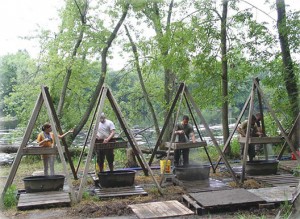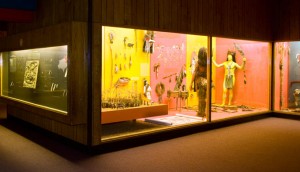The Great Pyramids of Egypt as well as the marble columns of Rome and Greece have never been questioned to be anything other than immaculate structures created by the people of that time period. The same credit however was not originally transferred to the works of Natives around the globe. Prior to the evolvement of archaeology and the use of scientific calculations such as carrying capacity, the assumptions made during the speculative phase were the be-all end-all. People were only categorized as savages, barbarians or civilized, whereas savages and barbarians were deemed “incapable” of any mode of civilized behavior. It was originally thought that when sophisticated features and artifacts where discovered, Europeans or other “civilized” groups already inhabited the area and left. In reality, the Native Americans were responsible for the evidence of civilization and most likely deserted the area to avoid being enslaved.

Figure 1: Archaeologists recovered many artifacts from the site of the Fort of St. Joseph, including an ornate crucifix of a Native woman. This crucifix exemplifies melding as Native women were clearly baptized.
Even long after the impractical assumptions of the speculative phase, everyday people as well as some archaeologists are still neglecting evidence of civilized behavior demonstrated by Native Americans. In an article discussing the rapid rise and fall of a French Fort, Native Americans were wrongly accused for the slaughter of the French inhabitants due to the ignorant assumption that Native Americans were not educated and/or sophisticated enough to have a civil and peaceful interaction. It was not until recently, after thorough analysis of artifacts and ecofacts at the site, that the relationship between the Native Americans and French was determined as a melding of civilized cultures rather than a collision. Examples of civilized melding include that the French had been hunting with Native weapons and that the two groups were married with bi-culturally raised children. As anthropologist T.R. Kidder correctly put it, “Our findings go against what has been considered the consensus on hunter-gatherer societies — that they lack the political organization necessary to complete a labor-intensive project in such a short period.”

Figure 2 American Museum of Natural History where dinosaur fossils, exotic hissing cockroaches, and wondrous planetariums–right next to priceless human designed art and artifacts created by Native peoples of the Americas
Museums worldwide, such as the Museum of Natural History, wrongly place Native American art and sculptures in similar categories with dinosaur remains and tribal arts. In my opinion, this lends to the idea that Native American art is considered uncivilized and simplistic. Fortunately, other archaeologists who are still working vigorously to solve the problem, have supported my own opinion. A new exhibit called “Stereotyping Native America” features turn of the 20th Century stereotypes of Native Americans such as the mainstream American typologies that they lived in teepees, and wore feathers and animal skins. The need for these kinds of museums and exhibits indicate what little progress mainstream America has made in understanding the multifaceted history of Native Americans.
Further Reading:
Am. Archaeology. (n.d.). Retrieved September 13, 2014, from http://daphne.palomar.edu/ais130/Lectures/AmArchaeo.htm
Fort St. Joseph Archaeological Project. (n.d.). Retrieved September 13, 2014, from http://fortstjosepharchaeology.blogspot.com
References:
Stereotyping Native America. (n.d.). Retrieved September 13, 2014, from http://138.23.124.165/exhibitions/stereotyping/default.lasso
http://www.archaeologicalconservancy.org/6-u-s-forts-didnt-learn-history-class/

In your blog post, you note the harmful categorization of Native Americans as “uncivilized” and “savage” by their European colonizers. From this observation, the importance of language in archaeology and culture becomes clear. People regularly use the terms “civilized” and “uncivilized” even today, which imply that some cultures are better or more developed than others. A single word has the power to attach a certain identity or values to an entire people. A single word can assert their lower place within a larger power structure. Conceptualizing the world in these terms results from ethnocentrism – the process by which one evaluates other cultures purely from the perspective of one’s own culture. In the case of the Native Americans, this language translated into assumptions and stereotypes that defined Euro-Native American relations. Thinking about how language can reveal and perpetuate such harmful ways of thinking, it is interesting to consider what types of language are used in archaeology today. How do archaeologists write about the peoples they study? What types of descriptive words do they use?
As previously noted in my last response, synonyms for the words “civilized” and “uncivilized” exhibit harsh judgements toward those societies deemed uncivilized. For this reason, word choice is very important in not only archaeology today but life in general. Processual archaeology begins to stray away from biases due to its use of scientific developments to create explicit explanations for cultural differences. This however still does not change to word choice commonly used. I think an issue emerges in word choice when trying to be descriptive, but unbiased. It becomes hard to balance the two entities and successfully get your point across. Another example includes gender-biased language which implies that people are male unless ‘proven’ to be female. Is there really a finite way to describe something without a trace of bias?
“Civilized” and “civilization” are words I struggle with as a professor. If I don’t critique them in class students continue to use them in the biased way our culture teaches them to. If I do use them in class it seems to legitimize the concept of civilization. Instead of terms misapplied to one culture or time period, the concept of civilization is an inherently flawed one.
The use of the words “civilized” and “uncivilized” and the description of many Native American societies as “uncivilized” I think helps to illuminate the civilized racism that existed during the speculative phase. A scientific definition for “civilization” is “a form of complex society in which many people live in cities,” popularly, associated most closely with European empires. Interestingly, common synonyms for the word “civilized” include “educated,” “cultured,” and “sophisticated” while synonyms for “uncivilized” include “barbaric,” “savage,” and “undeveloped.” Evidently, a harsh moral judgement is imposed on those societies deemed “uncivilized.” Using the term “uncivilized” further implies the injustice toward the Native Americans.